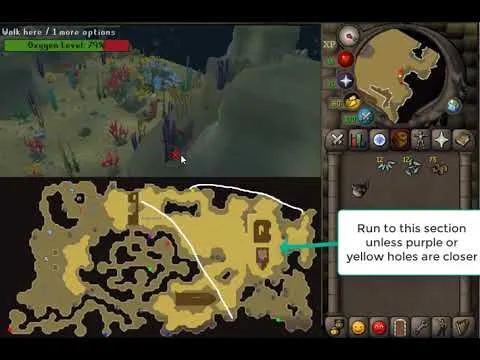Your cart is empty
How to Get Seaweed Spores in OSRS A Complete Guide

Seaweed spores are a valuable resource in Old School RuneScape (OSRS), essential for growing giant seaweed in the underwater area of Fossil Island. Whether you’re an Ironman looking to craft molten glass or a player chasing the Tangleroot pet, knowing how to efficiently gather seaweed spores is key. This guide covers the best methods to obtain them, from passive collection to active grinding, ensuring you can stock up with minimal hassle. Let’s dive into the details!
Before we explore how to get seaweed spores, it’s worth understanding their importance. These spores are used in the Farming skill at level 23 to plant in seaweed patches, yielding giant seaweed after about 35-40 minutes. Giant seaweed is a game-changer for Ironmen, offering high crafting experience through molten glass production with the Superglass Make spell. Plus, farming giant seaweed gives a decent shot at the Tangleroot pet, making spores a hot commodity.
Key Uses of Giant Seaweed
- Crafting Molten Glass: Two giant seaweeds and 12 buckets of sand yield about 1.45 molten glass per sand, netting 538-669 Crafting XP per seaweed depending on what you make (e.g., lantern lenses or light orbs).
- Tangleroot Farming: Seaweed patches have a relatively high chance of granting this rare pet compared to other crops.
- Soda Ash Production: Cooking giant seaweed on a fire produces six soda ash, useful for glassmaking.
Passive Methods to Collect Seaweed Spores
If you prefer low-effort methods, passive collection is the way to go. These approaches let you gather spores while doing other activities, making them ideal for players who want to multitask.
Diving in Shallow Water on Fossil Island
One of the easiest ways to get seaweed spores is by hanging out in the underwater area of Fossil Island. Spores randomly spawn in shallow water, visible only to you, and despawn after 30 seconds. They appear with a cloud of bubbles, so keep an eye out.
- How It Works: A timer ticks while you’re underwater, with a 1% chance per tick to spawn 1-3 spores. They don’t stack up if you miss them, so grab them fast.
- Pro Tip: Use the Runelite plugin to highlight seaweed spores on the ground and enable notifications for spawns. This makes spotting them effortless.
- Efficiency: Expect 5-10 spores per hour if you’re actively watching, or fewer if AFK.
- Setup: Equip a diving apparatus and fishbowl helmet, then skill near the seaweed patches. Spores spawn nearby, so you can grab them between tasks.
- Best Skills: Fletching headless arrows or blowing glass works well since you’re already in the area.
- Yield: Around 5-6 spores per hour while AFK, more if you’re attentive.
- Requirements: 43 Slayer and a weapon like the brine sabre or trident of the seas (magic attacks work best).
- Strategy: Kill lobstrosities near seaweed patches to also pick up random spawns. A cannon can speed things up if you’re not an Ironman.
- Yield: Expect 50-100 spores per hour with high efficiency, plus XP in combat skills.
- Setup: Train at spots south of volcanic ash spawns. Equip a ring of wealth to auto-loot numulite for patch protection.
- Benefits: Low combat requirement and decent XP, with 5-10 spores per hour.
- Drawback: Slower than lobstrosities due to the lower drop rate.
- Requirements: 66 Slayer and high combat stats. Use ranged or melee with a dragonfire shield.
- Efficiency: Around 10-20 spores per hour, but you’ll also get other valuable drops like fossils.
- Note: Best done on a Slayer task for bonus XP and efficiency.
- Requirements: 38 Thieving (higher levels improve success rate).
- Drop Rate: Roughly 1/2200 (0.045%), so expect slow returns.
- Perks: You’ll also get other seeds (herbs, trees, allotments), making it decent for Ironmen training Thieving.
- Cost: 20 mermaid’s tears per spore (down from 50 after a 2018 update).
- Strategy: Do underwater thieving for tears and spores simultaneously. Expect 8-10 spores per hour with 65 Thieving.
- Tip: This is a reliable option if you’re low on spores and don’t want to grind combat.
- Setup: Maintain high approval and allocate workers to the farm.
- Yield: Sporadic and low, but it’s completely passive.
- Best For: Players already managing their kingdom for other resources.
- Use Ultracompost: Boosts seaweed yield (20-40 per patch vs. 8-16 without), increasing your Crafting XP and pet chances.
- Don’t Pay Mernia: Protecting patches with 200 numulite isn’t worth it unless you have excess. Only 5% of patches die, and you’ll save resources by skipping this.
- Harvest and Replant: You can sustain about 50% of your spores by picking up spawns during farming runs. Start with 50-100 spores to break even long-term.
- Combine Activities: Pair spore collection with training Slayer, Thieving, or bankstanding skills to maximize XP across multiple skills.
- Track Spawns: Use Runelite’s ground item plugin with a notification sound to never miss a spore spawn underwater.
AFK Skilling Near Seaweed Patches
Combine spore collection with bankstanding skills like fletching, alching, or glassblowing underwater. This method is perfect for Ironmen who want to multitask.
Active Methods for Faster Seaweed Spores
For players who want to stockpile spores quickly, active methods involve combat or skilling with higher focus. These are great for dedicated grinding sessions.
Killing Lobstrosities
Lobstrosities, found underwater on Fossil Island, are a top choice for farming spores due to their generous drop rate.
| Monster | Drop Rate | Quantity | Combat Level |
|---|---|---|---|
| Lobstrosities | 1/20 (5%) | 5 spores | 68 |
Hunting Ammonite Crabs
Ammonite crabs on Fossil Island’s surface are another solid option, especially for lower-level players.
| Monster | Drop Rate | Quantity | Combat Level |
|---|---|---|---|
| Ammonite Crabs | 1/128 (0.78%) | 2 spores | 25 |
Farming Fossil Island Wyverns
For higher-level players, Fossil Island wyverns offer a chance at bigger spore drops, though they’re tougher to kill.
| Monster | Drop Rate | Quantity | Combat Level |
|---|---|---|---|
| Fossil Island Wyverns | 1/65 (1.54%) | 12 spores | 139-147 |
Alternative Sources for Seaweed Spores
Beyond combat and passive collection, there are a few other ways to snag spores, especially for players with specific skills or resources.
Pickpocketing Master Farmers
Master Farmers, found in places like Draynor Village or Hosidius, can yield seaweed spores, though it’s a rare drop.
Buying from Mairin’s Market
If you’ve got mermaid’s tears from underwater activities like thieving or agility, you can trade them at Mairin’s Market.
Managing Miscellania
If you’ve completed the Throne of Miscellania quest, assign workers to farming for a chance at seaweed spores.
Tips to Maximize Your Seaweed Spore Collection
No matter which method you choose, these tips will help you gather spores more efficiently and make the most of your time.
Sustaining Your Spore Supply
Once you have a stack of 50-100 spores, farming giant seaweed becomes self-sustaining. Spores spawn during your runs, replacing about half of what you plant. For example, farming 100 spores yields roughly 36.9 seaweed per live patch, banking around 2.45M Crafting XP from 87 to 99 Crafting.
Best Method for Your Playstyle
Choosing the right method depends on your account and goals:
| Method | Best For | Spores/Hour |
|---|---|---|
| Lobstrosities | High-combat Ironmen | 50-100 |
| AFK Skilling | Multitaskers | 5-10 |
| Mairin’s Market | Thieving-focused players | 8-10 |
| Ammonite Crabs | Low-level players | 5-10 |
Final Thoughts on Gathering Seaweed Spores
Getting seaweed spores in OSRS doesn’t have to be a grind. Whether you’re killing lobstrosities for fast drops, AFKing underwater while skilling, or trading mermaid’s tears, there’s a method for every playstyle. Start with a small stack, use ultracompost, and leverage Runelite to make collection a breeze. With these strategies, you’ll have enough spores to farm giant seaweed for Crafting XP, soda ash, or that elusive Tangleroot pet. Happy farming!
Pro Tip: If you’re an Ironman aiming for 99 Crafting, you only need about 180-200 spores to start, as passive spawns cover the rest. Get out there and dive in!
